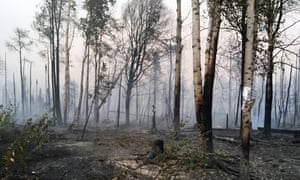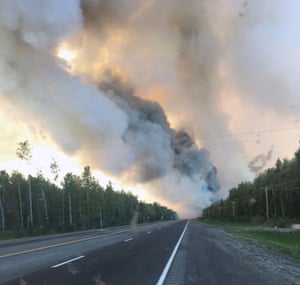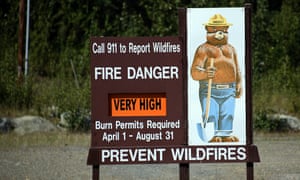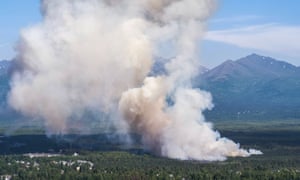For residents of Anchorage, July’s wildfire and unprecedented
temperatures plus the current McKinley Fire confirm that global heating
has changed life forever
Major fires are burning this week in south-central Alaska, lengthening the state’s wildfire season, which has usually ended by the beginning of August.
They come after Alaska’s hottest July on record, during which its largest city, Anchorage, had a temperature pass 90F (32C) for the first time. On top of that, the area has seen little rain this summer, resulting in extremely dry conditions.
As firefighters tackle the blazes, officials are facing the longer term challenges of keeping the region safe amid increasing evidence of the impacts of the climate crisis.
"Everything points to more fires, longer fire seasons and more intense fires"
Wildfires
are a growing concern around the country. According to the latest
National Climate Assessment, hotter, drier conditions over the past two
decades have led to more area being burned across the US.They come after Alaska’s hottest July on record, during which its largest city, Anchorage, had a temperature pass 90F (32C) for the first time. On top of that, the area has seen little rain this summer, resulting in extremely dry conditions.
As firefighters tackle the blazes, officials are facing the longer term challenges of keeping the region safe amid increasing evidence of the impacts of the climate crisis.
"Everything points to more fires, longer fire seasons and more intense fires"
To make matters more perilous, since the 1990s, many millions of homes around the country have been built in or near forested areas, such as in the town of Paradise, California, the scene of a deadly wildfire last year.
In Anchorage, which has a population of around 294,000, a few small fires have broken out within the city limits this summer. While much less destructive than this week’s blazes in the south-central region, they gave officials notice of a growing new threat inside the city.

“They are wondering if this is a glimpse of a future, warmer Anchorage,” Brettschneider said.
Major fires
Around 80 miles north of Anchorage, the over over 3700-acre (1500 hectare) McKinley Fire, which started over the weekend, continues to blaze. No casualties have been reported yet, but the fire has destroyed an estimated 80 structures so far. Many people living along the highway between Anchorage and Denali National Park have been forced to evacuate.
Anchorage itself experienced a fire scare in early July, heralded by a plume of smoke rising from a wooded area on the east side of the city.
Firefighters rushed to the scene and soon reported 60ft (18m) flames leaping from a black spruce forest. Helicopters and air tankers zoomed in to douse the quickly spreading blaze with water and fire retardant. Nearby homes were evacuated. Crews managed to contain the fire and in this case, no homes were lost.
“It was scary,” said John See, a forester with the Anchorage Fire Department. “It was a really high priority fire, in a bad place.”
This summer’s wildfires are taking place amidst unusual conditions, to put it mildly. The July fire in Anchorage broke out at the start of what the US National Oceanic and Atmospheric Association described as “a period of warmth that re-wrote the record books” in Alaska.
High temperatures persisted through August and little rain fell. Combined with especially high winds early this week, conditions were perfect for wildfires, worsening blazes that were already burning and stoking new ones.

This is the result of multiple factors, he said. Alaska’s fire season is usually earlier than the season in the contiguous US, taking place in late spring and early summer. Humidity is lowest, as well as it being the driest and windiest time of year. What usually helps mitigate those conditions, Brettschneider said, is lingering snow cover. But due to global heating, snow in the Anchorage area is melting earlier, extending the length of the season. And as temperatures go up, conditions are getting even drier.
“Everything points to more fires, longer fire seasons and more intense fires,” said Brettschneider. “There is no silver lining.”
Alaska on the front line
In addition to wildfires, the city of Anchorage is trying to prepare for a laundry list of other near and long-term issues, outlined in the Climate Action Plan the city adopted this spring.More frequent freeze-thaw events in winter are transforming the city’s streets and sidewalks into skating rinks. Biologists fear that rising temperatures could lead to the arrival of winter ticks, threatening Anchorage’s ubiquitous population of urban moose. The city is also keeping a close eye on the retreat of the nearby Eklutna Glacier, which provides the bulk of Anchorage’s drinking water supply and is expected to disappear in 100 years or less.

“Anchorage is surrounded by forested areas, and we’ve got a large population that is connected to those areas,” said Kilcoyne. “This is definitely a big threat for Anchorage residents, and it is something that the municipality is taking very seriously.”
"After what we’ve experienced this summer, it does make you wonder what’s ahead of us. Is this going to be the norm?"
In addition to the threat to human health and safety, fighting and recovering from wildfires can come with a hefty price tag. A recent report from the University of Alaska’s Institute of Social and Economic Research projected that due to increased climate risk, wildfires could cost the state an additional $25-$40m per year over the next three to five decades.
The research did not provide estimates for individual Alaska cities, but co-author Jennifer Schmidt said it’s unlikely that Anchorage will be immune to increased wildfire costs.
Schmidt, who is leading the Urban Forest and Watersheds working group under Anchorage’s Climate Action Plan, said looking at increased wildfire risk through the lens of climate change is important. The severity of Alaska’s wildfire seasons can be erratic year-to-year, Schmidt said, but large fire years are increasing statewide.
“It’s an overall trend and we have to take a long term vision,” said Schmidt.
Anchorage is taking steps to deal with the problem. Anchorage forester See is in charge of coordinating the city’s wildfire mitigation program, and spends a lot of time helping homes and neighborhoods reduce their risk through the Firewise program. See advises residents to thin trees around their houses, install non-combustible roofs and make sure emergency crews are able to easily access their neighborhoods.
See estimates the city has completed work on nearly 3,000 homes, but there are many more at risk. “We’ve scratched the surface,” said See. “You can take a drive on the hillside and see just hundreds of homes that really need Firewise.”
This summer’s conditions in the area surrounding the city have highlighted the urgency of the situation. “After what we’ve experienced this summer, it does make you wonder what’s ahead of us. Is this going to be the norm?” said See. “And if it is, then boy, we really need to do some different things here.”
Follow Guardian Cities on Twitter, Facebook and Instagram to join the discussion, catch up on our best stories or sign up for our weekly newsletter


No comments:
Post a Comment